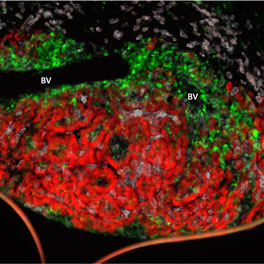Cancer immunology has tremendous therapeutic promise, as the immune system has the potential to find and completely eliminate tumor cells throughout the body and provide long lasting immunity from cancer. We are currently investigating how immune cells and tumor cells interact during tumor development and how productive and non-productive anti-tumor immune responses affect the development of cancer in mice. Standing in the way of potent anti-tumor responses by immune cells are natural “road-blocks” that prevent the immune system from attacking the body. Complete elimination of these “road-blocks” could be fatal. The key to successful therapeutic stimulation of anti-tumor responses lays in understanding how to ease the regulations on the immune system and allow anti-tumor responses to occur. The cancer immunology group in our lab focuses on two main groups of cells: T cells and NK cells. The interactions between tumor cells and T cells have been studied for many years. However, the reason why T cells do not naturally eliminate tumor cells (as they do infected cells) remains unclear. The lab is also focused on natural killer (NK) cells, thought to kill tumor cells in the body, and finding ways to target these cells towards tumors. As T cells and NK cells play an important role in lung cancer development and modulating these pathways maybe a viable therapeutic strategy for improving outcomes for patients with lung adenocarcinoma. In addition, the lab is interested in understanding the role of other innate immune cell types such as macrophages and dendritic cells in the recognition of developing tumor lesion and instruction of adaptive anti-tumor immunity.

Immune cells interacting with a developing lung tumor (lung sections from a KrasLSL-G12D, Trp53FL/FL, Rosa26LSL-Tomato (KP-T) mouse ~20 weeks after infection with 25,000 PFU LucOS/Cre Lentivirus). Green CD3+ T lymphocytes (T cells) clustered near tumor associated blood vessels (BV). T cells are also in close association with red tumor cells, which express a strong T cell antigen, Ovalbumin. White CD11c+ dendritic cells and macrophages (distinguished based on morphology) surround and infiltrate the tumor.

